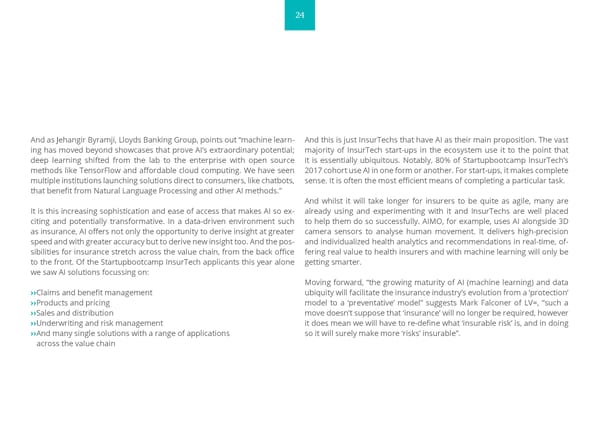24 And as Jehangir Byramji, Lloyds Banking Group, points out “machine learn- And this is just InsurTechs that have AI as their main proposition. The vast ing has moved beyond showcases that prove AI’s extraordinary potential; majority of InsurTech start-ups in the ecosystem use it to the point that deep learning shifted from the lab to the enterprise with open source it is essentially ubiquitous. Notably, 80% of Startupbootcamp InsurTech’s methods like TensorFlow and affordable cloud computing. We have seen 2017 cohort use AI in one form or another. For start-ups, it makes complete multiple institutions launching solutions direct to consumers, like chatbots, sense. It is often the most efficient means of completing a particular task. that benefit from Natural Language Processing and other AI methods.” And whilst it will take longer for insurers to be quite as agile, many are It is this increasing sophistication and ease of access that makes AI so ex- already using and experimenting with it and InsurTechs are well placed citing and potentially transformative. In a data-driven environment such to help them do so successfully. AIMO, for example, uses AI alongside 3D as insurance, AI offers not only the opportunity to derive insight at greater camera sensors to analyse human movement. It delivers high-precision speed and with greater accuracy but to derive new insight too. And the pos- and individualized health analytics and recommendations in real-time, of- sibilities for insurance stretch across the value chain, from the back office fering real value to health insurers and with machine learning will only be to the front. Of the Startupbootcamp InsurTech applicants this year alone getting smarter. we saw AI solutions focussing on: Moving forward, “the growing maturity of AI (machine learning) and data ››Claims and benefit management ubiquity will facilitate the insurance industry’s evolution from a ‘protection’ ››Products and pricing model to a ‘preventative’ model” suggests Mark Falconer of LV=, “such a ››Sales and distribution move doesn’t suppose that ‘insurance’ will no longer be required, however ››Underwriting and risk management it does mean we will have to re-define what ‘insurable risk’ is, and in doing ››And many single solutions with a range of applications so it will surely make more ‘risks’ insurable”. across the value chain
 PwC & Startupbootcamp InsurTech: READY FOR TAKE OFF Page 23 Page 25
PwC & Startupbootcamp InsurTech: READY FOR TAKE OFF Page 23 Page 25